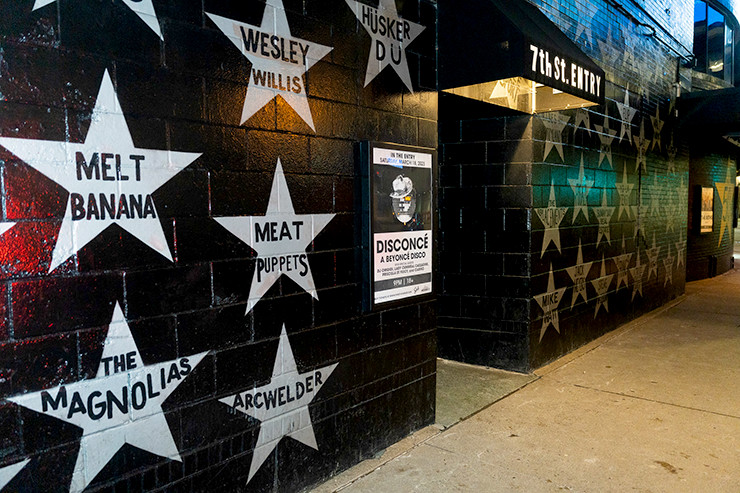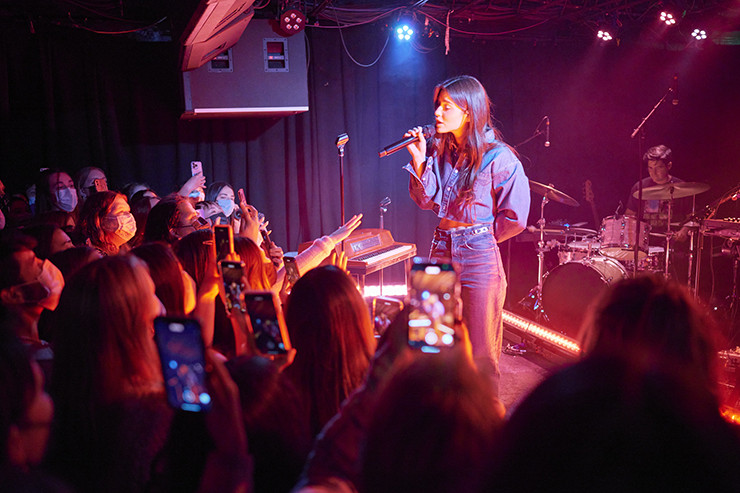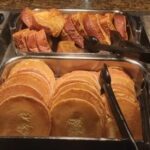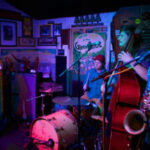The 7th Street Entry isn’t just a venue; it’s an experience etched into memory with unforgettable intensity. This space, raw and intimate, forges a connection between artists and audiences that can reverberate for decades. Chrissie Hynde, the iconic frontwoman of The Pretenders, understands this intrinsic power. Fresh off a stadium performance in Toronto opening for Guns N’ Roses in front of 50,000 fans, The Pretenders chose to reconnect with their roots at the Entry, playing for an audience of just 250 on a Thursday night.
They could have easily chosen First Avenue, the larger, neighboring nightclub accessible through a shared doorway. First Avenue hosted The Pretenders early in their career, back in April 1980, a performance that played a part in shifting the club’s identity away from its disco origins. However, First Avenue’s fame has grown globally, largely due to its association with Prince and the movie “Purple Rain,” transforming it into a major tourist destination and a site of pilgrimage for fans since his passing in 2015.
The 7th Street Entry offers a different, more understated allure. Less globally recognized, it holds a unique and potent magic all its own.
More Than Just Next Door to First Avenue
The 7th Street Entry’s history officially began with a Curtiss A (Almsted) gig in March 1980, but Steve McClellan, who managed both venues for over three decades, recalls informal performances by The Wallets even before that. “I was there that very first night of music,” remembers Jim Walsh, a writer and musician who performed at the Entry with multiple bands and documented its scene for years. “(Wallets front man) Steve Kramer jumped on the bar and tightrope-walked his way down to the cash register, ripped out some bills and started throwing change, singing a song I don’t think they had even recorded yet.”
In its initial years, the layout was reversed, with the bar where the stage is now. McClellan chuckles, reflecting on the venue’s humble, underfunded beginnings. Originally, the space served as a coat check for Uncle Sam’s, the disco that predated First Avenue. During renovations, they discovered its past life as a diner within the Greyhound bus terminal. “I still have an old menu in a box somewhere,” McClellan shares, “I didn’t keep the jars of pickles that we found.”
The 1980s saw the Entry evolve into a beloved, albeit rundown, haven. The roof leaked, the single bathroom’s toilet was often clogged, and graffiti constantly layered its walls. The color scheme was even more intensely black than First Avenue, and the ever-present indoor smoking led some to nickname it “The Ashtray.”
 Exterior view of 7th Street Entry
Exterior view of 7th Street Entry
Until Prince propelled First Avenue to international fame, the Entry was actually the financial engine of the building.
Yet, this claustrophobic setting paradoxically fostered an unparalleled intimacy and immediacy for live music. The low ceilings, hard, soot-stained walls, and sharp angles combined to create an acoustic marvel, even at high volumes. And you could find yourself mere feet from extraordinary talent. In its early days, McClellan aimed to book reggae and “world music.” Flyte Tyme, the precursor to The Time featuring Jimmy Jam and Terry Lewis, graced the Entry stage.
“I remember a night when the Pedal Jets, a band from Lawrence, Kansas, was scheduled,” Walsh recounts. “Prince walked in with three members of The Revolution—just as Purple Rain was reaching its peak—and announced, ‘we’re not as good as the band that’s here tonight, but we’re going to play a little.’ And they played for about 30 minutes.”
The “Hallowed Dump” Era: Punk Rock Roots
Beyond these extraordinary moments, the Entry increasingly became a sanctuary for hardcore rock ‘n’ roll in the 80s and early 90s. The Longhorn, another downtown venue catering to punk and new wave, closed soon after the Entry opened. While McClellan acknowledges that some acts and audiences were initially deterred by the venue’s dilapidated state, local punk enthusiasts embraced the tiny, gritty space, drawing comparisons to the legendary CBGB in New York.
“Within a few years, the market, not me, had decided the Entry was not going to be a diverse room. It was going to be a punk club,” McClellan stated.
And what a punk haven it became. The bands spearheading the punk-influenced “Minneapolis Sound”—The Replacements and Husker Du—thrived at the 7th Street Entry. They paved the way for the national rise of grunge and harder rock acts like Nirvana, Green Day, and The Pixies. Husker Du’s debut album was recorded live at the Entry. The Replacements’ week-long residency at the venue became legendary, a tradition later echoed by Slug and Atmosphere when hip hop gained prominence in the space from the mid-90s onward.
Before Prince elevated First Avenue to global recognition, the Entry was the building’s financial backbone. And as First Avenue’s star rose, successful local bands from the Entry earned opportunities to open for, or even headline, shows in the larger venue.
“It was a breeding ground,” Walsh explains. “You’d play the Entry and then Steve might say, ‘Hey, you want to open for the Ramones?’ And when they started the Best New Bands of the Year showcases, they’d all play at the Entry around New Year’s Eve.”
Hip-Hop’s Arrival and Community Vibe
Peter Scholtes, another musician and former City Pages writer who followed the Entry scene a decade after Walsh, also performed in bands and chronicled the venue. Reflecting on the sense of community there, he recalls, “…going to see Stereolab (an indie rock band) in the early ‘90s and feeling the whole room vibrate to the same pulse. It’s this shared joy, like when everyone in a theater laughs together. There’s no better place to experience a great live band. The sound and sense of collective energy are incredibly immediate.”
Scholtes, an expert on Twin Cities hip hop history, credits the Entry as a vital launchpad for the genre locally. It began with artists like I Self Divine with the Micranots, and later Atmosphere and the Rhymesayers Entertainment collective.
The introduction of hip-hop into the Entry’s musical landscape drew John Labree into becoming a regular, a habit he continues to this day. “It became a scene hub, where you knew Headshots or Rhymesayers were going to be performing.”
The unpredictable nature of the shows is another draw for Labree. “It could be just you and the merch guy in the place, or it could be a crowd of fanatics who are completely immersed, and the performer is inspired and rises to the occasion. Knowing you were there watching people break into the scene, where the Entry is a significant gig, and seeing them grow bigger, it’s pretty cool.”
 Singer-songwriter Gracie Abrams performing at 7th Street Entry
Singer-songwriter Gracie Abrams performing at 7th Street Entry
Singer-songwriter Gracie Abrams captivating the audience at the intimate 7th Street Entry.
“Then there’s the physical space itself,” Labree adds. “Like, I walked out of the restroom and snapped a picture of (Australian jazz band) Surprise Chef, and people on my feed were asking, ‘Are you in the band?’ and ‘Were you on stage?’ No, it’s just that everything is so close.”
Intimacy and Unpredictability: The 7th Street Entry Experience
The 7th Street Entry now boasts two restrooms, mostly clean and free of graffiti. While some behind-the-scenes renovations have occurred, the public-facing layout remains largely unchanged—if it’s not broken, don’t fix it. Seating is still limited. Along the back wall, a raised, two-tiered platform offers a place to sit, reminiscent of a shoeshine stand. A handful of stools line the ledge separating this platform from the lower floor in front of the stage, which can accommodate around 70 people.
The author’s first experience at the Entry was shortly after moving to town in 1985, seeing the thrash band The Minutemen. The sound was intensely powerful. Since then, with a brief interruption for COVID, they have returned regularly, including a concentrated period of about a dozen shows in August to reassess the venue.
While it’s tempting to think the Entry might never recapture its 80s punk rock zenith or the hip-hop fervor of Atmosphere’s week-long takeovers, such nostalgia might stem from the selective nature of memory.
Labree’s point about unpredictability rings true. If time and budget allow (most shows are under $20, but frequent visits add up), the variety is a real draw. The range of genres and band recognition is perhaps wider than ever. Recent visits included country-folk, hip-hop, aggressive punk, melodic soft rock, and bubblegum pop acts, some incorporating computer mixes instead of live bands.
 Singer-songwriter Gracie Abrams performing at 7th Street Entry
Singer-songwriter Gracie Abrams performing at 7th Street Entry
A young Billie Eilish performing in the intimate setting of the 7th Street Entry.
Even sparsely attended shows radiate a sense of community. A gender-fluid trio of Black performers drew an enthusiastic LGBTQ+ crowd who spontaneously line-danced to a drag queen lip-syncing Erykah Badu’s “Tyrone.” Hard rock openers each brought dedicated fan groups resembling enduring high school cliques. And, consistently, regardless of genre or popularity, parents and grandparents of local acts are easily spotted in the audience. “My mother still talks about the time she went to the Entry and saw all three of her sons in different bands on the same night,” Walsh recounts.
You never know when you’ll witness something extraordinary. Scholtes estimates being one of just 20 people to see a fledgling White Stripes at the Entry. Walsh brought his daughter to see Billie Eilish there in 2017, before her meteoric rise to fame.
During the author’s August visits, they caught Sweeping Promises, a Boston duo now based in Lawrence, Kansas, touring with a drummer. The singer was a captivating force with brilliant lyrics; the guitarist, a sublime minimalist. It’s unlikely they’ll ever be seen in such an intimate space again.
They also saw Student 1, the third act in a hip-hop showcase. A first-generation American of Ethiopian descent, raised in Minneapolis, his stage presence was effortlessly confident, his movements fluid, his raps light yet sharp, catchy and charming. Where other acts leaned into cliché aggression, Student 1 appeared reflective, even in fleeting phrases, and even lay down on stage during a couple of “slow songs.” It was a uniquely memorable performance, perfectly suited to the 7th Street Entry.


